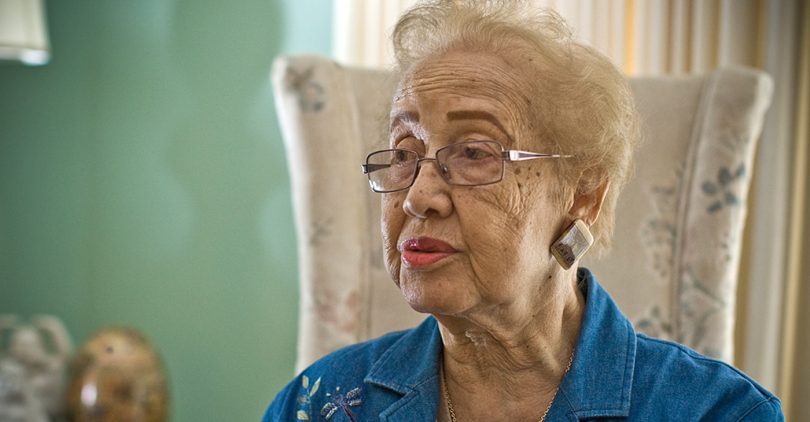
By Stacy M. Brown / NNPA Newswire Correspondent / @StacyBrownMedia
For many, the words of a senior scientist who said physics “was invented and built by men,” stung. The words earlier this month of Professor Alessandro Strumia, who was suspended from working with the European nuclear research center, Cern, served as a reminder of the great accomplishments of Katherine Johnson, who recently turned 100.
Celebrate indeed. Strumia also claimed in his controversial comments that physics is “becoming sexist against men.”
“Let’s celebrate our sister leader, Katherine Johnson,” NNPA President and CEO Dr. Benjamin F. Chavis, Jr., said this week. “We’re reminded,” Chavis said, “of Johnson, who hand-crunched the numbers for America’s first manned space flight – a feat that finally got its Big Screen acknowledgement just two years ago. Katherine Johnson’s historic contributions to the evolution of applied mathematics and aerospace science epitomizes her genius to overcome the scientific challenges of her generation.”
“Today, African American women in particular should be inspired by the example of Katherine Johnson in STEM career fields,” Chavis said. “The NNPA salutes Johnson’s transformative legacy that is no longer hidden.”
The recipient of the 2015 National Medal of Freedom who was also recognized by People Magazine in 2016 as one of the 25 Women Changing the World, Johnson enjoyed a brilliant 33-year career at NASA.
That portion of her life story was featured on the big screen in “Hidden Figures,” the award-winning movie, starring Taraji P. Henson, Octavia Spencer and Janelle Monáe.
In an earlier interview, she told NNPA Newswire that she missed working. “I’d go back now,” she said.
After leaving her teaching job in 1953, Johnson began working for NASA, “hand” calculating the trajectories for several space missions, including for the famed space flight of Alan Shephard, the first American in space, and the trajectory for the famed 1968 Apollo 11 flight to the Moon.
“I’d do them over if I had to. I’d do anything for anyone,” she said.
At an early age, Johnson developed enviable math skills that are recounted on the NASA websitein featured piece titled, “The girl who loved to count.” “I counted everything. I counted the steps to the road, the steps up to church, the number of dishes and silverware I washed … anything that could be counted, I did,” Johnson said.
“I entered college, I was 15. I was going to be a math teacher because that was it. You could be a math teacher or a nurse, but I was told I would make a good research mathematician and they had me take all of the courses in the catalogue,” she said.
When Astronaut John Glenn went to the moon, Johnson said her “Hidden Figures” crew acted as the computer for the mission. She said calculating everything involved in the flight became like a geometry problem.
“I felt most proud of the success of the Apollo mission. We had to determine so much. Where you were, where the moon would be and how fast the astronauts were going,” Johnson said.
“We were really concerned but the astronaut had to do it just as we laid it out. I was looking at the television and hoping that we were right,” she said.
Born in 1918 in West Virginia, Johnson was a research mathematician, who by her own admission, was simply fascinated by numbers, according to her biography posted by NASA. By the age of 10, Johnson was a high school freshman – an amazing feat in an era when school for African-Americans normally stopped at eighth grade.
Her father was determined that Johnson would have a chance to meet her potential. “He drove the family 120 miles to Institute, West Virginia, where I could continue my education through high school,” she said.
An achiever at the highest level, Johnson graduated from high school at 14 and from college at 18.
By 1953, the growing demands of early space research meant there were openings for African American “computers” (a term that held a different meaning at that time than it does today) at Langley Research Center’s Guidance and Navigation Department – and Johnson found the perfect place to put her extraordinary mathematical skills to work.
Glenn requested that she personally recheck the calculations made by the new electronic computers before his flight aboard Friendship 7 – the mission on which he became the first American to orbit the Earth.
She continued to work at NASA until 1986.
Her calculations proved as critical to the success of the Apollo Moon landing program and the start of the Space Shuttle program as they did to those first steps on the country’s journey into space, according to NASA.
Still, Johnson said the book, the Academy Award-nominated movie and her celebrated work with NASA aren’t her greatest accomplishments.
“Just staying alive is the greatest accomplishment,” she said.

